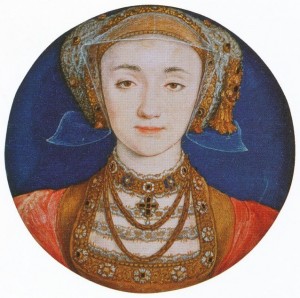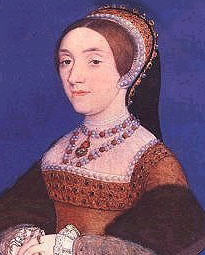 What a difference a year made for Anne of Cleves!
What a difference a year made for Anne of Cleves!
On 3rd January 1540 Anne was officially received by her soon-to-be husband, Henry VIII, at a spectacular pageant that spread from Greenwich Park to Blackheath. Chronicler Edward Hall1 describes the spectacle that greeted Anne:
“On the morow being the third day of lanuary, & Saturday, in a fayre playne on black heth more nerer the foote of shoters hyl, then the ascendent of the hyll called blacke heth hyl, was pitched a riche cloth of gold & dyuers other Tentes & Pauilions in the which were made fyers and perfumes for her and suche Ladies as should receyue her Grace:
and from the Tentes to the parke gate of Grenewych were all busshes and fyrres cutte downe, and a large and ample waye made for the shew of all persones […]”
He goes on to describe Anne’s arrival:
“About, xii. of the clocke her grace with all the company which were of her owne nacion to the nombre of a. C. horse, & accompanyed with the Dukes of Norffolke Suffolke, the Archebishop of Caunterburye other bysshops, lordes knyghtes which had receeyued & conueyed her as you haue heard before, came doune shoters hyll toward the Tentes & a
good space from the Tentes met her the Erie of Rutland her lorde Chautnberleyn, syr Thomas Denyce her Chauncellor, & all her councellers and officers, amongest whom, Doctor Daye appoynted to her Almoner, made to her an eloquent Oracion in latin, presentyng to her on the Kynges behalfe all the Officers & Seruauntes: which Oracion was answered vnto by the Duke her brothers Secretarie there beyng present: which done, the Lady Margarete Doglas, doughter to the Quene of Scottes, the lady Marques Dorcet, daughter to the French Quene being Nieces to the Kyng, the Dutches of Rychemond, the Countesse of Rutland & Herfford with dyuers other ladies gentlewomen, to the nombre of. lxv. saluted welcomed her Grace, which alighted out of her Chariot in the which she had rydden all her long iourney, & with most goodly demeanor & louyng countenauce gaue to them hertye thankes & kissed them all, & after all her councellors officers kyssed her hand, which done, she with all the Ladies entered the tentes, and there warmed them a space.”
When Henry VIII heard of arrival at the tent, he set off from Greenwich Palace through the park. Hall records his appearance:
“After hym a good distaunce followed the Kynges highnesse mounted on a goodly courser, trapped in ryche cloth of golde trauerced latyce wyse square, all ouer enbrodered with gold of dammaske, pearled on euery syde of the enbroderye, the buckles and pendentes were all of fyne golde. His persone was apparelled in a coate of purple veluet, somewhat made lyke a frocke, all ouer enbrodered with flatte golde of Dammaske with small lace mixed betwene of the same gold, and other laces of the same so goyng trauerse wyse, that the ground lytle appered: about whyche garment was a rvche garde very curiously enbrodered, the sleues and brest were cut lyned with cloth of golde, and tyed together with great buttons of Diamondes, Rubyes, and Orient Perle, his swoorde and swoorde gyrdle adorned with stones and especiall Emerodes, his night cappe garnished with stone, but his bonnet was so ryche of Iuels [jewels] that fewe men coulde value them. Besyde all this he ware in baudricke wyse a collar of such Balystes and Perle that few men euer saw the lyke: and aboute his persone ran. x. footemen all rychely apparelled in goldsmythes worke. And notwithstandynge that this ryche apparell and precious Iuelles [jewels] wer plesaunt to the Nobles all other being present to beholde, yet his Princely countenaunce, his goodly personage and royall gesture so farre exceded all other creatures beyng present, that in comparyson of his persone, all his ryche apparell was lytle estemed.”
Anne was “apparelled in a ryche goune of cloth of golde reised, made rounde without any trayne after the Dutche fassyon, and on her head a kall, & over that a rounde bonet or cappe set full of Orient Perle of a very propre fassyon, & before that she had a cornet of blacke veluet, & about her necke she had a parteletset full of riche stone which glystered all the felde.”
Anne came out of the tent, mounting a horse at the door of her tent, and rode out to meet Henry VIII. The king “put of his bonnet came foreward to her, & with most louely countenance and Princely behauyour saluted, welcomed & enbrased her to the great reioysyng of the beholders: and she lykewyse not forgettyng her duty, with most amiable aspecte & womanly behauyour receyued his Grace with many sweete woordes and great thankes and praisynges geuen to hym.” They then rode through the crowds to Greenwich Palace where they dismounted in the outer courtyard and the king “lovyngly embrased her and kissed her” before escorting her through the hall and to her privy chamber.
Henry VIII married Anne of Cleves on 6th January 1540 in the Queen’s Closet at Greenwich Palace.
A year later – 3 January 1541
 Just a year later and Anne of Cleves was visiting Hampton Court Palace to greet her former husband, Henry VIII, and his new wife, Catherine Howard. Her marriage to the king had been annulled on 9th July 1540 and the king had married Anne’s former maid-of-honour, Catherine Howard, on 28th July 1540. Eustace Chapuys recorded Anne’s visit and the New Year’s gifts she brought with her:
Just a year later and Anne of Cleves was visiting Hampton Court Palace to greet her former husband, Henry VIII, and his new wife, Catherine Howard. Her marriage to the king had been annulled on 9th July 1540 and the king had married Anne’s former maid-of-honour, Catherine Howard, on 28th July 1540. Eustace Chapuys recorded Anne’s visit and the New Year’s gifts she brought with her:
“[…] on the 3rd, Lady Anne of Clèves sent to the king as a new year’s present, two fine and large horses caparisoned in mauve velvet, with trappings and so forth to match, whilst she herself has made her appearance at Antoncourt (Hampton Court), where she arrived with her own retinue only, and no other courtier about her person except, perhaps, Milord Guillaume, the duke of Norfolk’s brother, who, having met her on the road to this city, could not well, for courtesy’s sake, refuse to accompany her to the gates of Antoncourt. At the door of the quarters prepared for her, Lady Anne was received by the duchess of Suffolk (Margaret), the countess Darfort, and certain other ladies, who, after conducting her to the rooms destined for her lodging, took her to the Queen’s apartments. There she had to wait a while until the Chancellor (Audeley) and the earl of Succez (Sussex) had fully instructed the Queen as to the manner in which she was to receive and treat her visitor. Having entered the room, Lady Anne approached the Queen with as much reverence and punctilious ceremony as if she herself were the most insignificant damsel about Court, all the time addressing the Queen on her knees, notwithstanding the prayers and entreaties of the latter, who received her most kindly, showing her great favor and courtesy.
At this time the King entered the room, and, after making a very low bow to Lady Anne, embraced and kissed her, upon which he and his queen sat down to supper in their usual places, whilst their visitor was made to occupy a seat near the bottom of the table, all the time keeping as good a mien and countenance, and looking as unconcerned as if there had been nothing between them. After supper all three conversed for a while in the most gracious manner, and when the King retired to his own apartments, the Queen and Lady Anne first danced together, and then separately, each with a partner chosen among the King’s gentlemen. Next day the three dined together; there was again conversation, amusement, and mirth, and on the King retiring to his apartments, as on the previous night, the Queen and Lady Anne danced together. Whilst thus engaged, the King sent to his queen by one of his confidential chamberlains a present, consisting of a ring and two small dogs, which present she passed over to Lady Anne – whether in the King’s name or in her own I cannot say, though, most likely, as is generally believed, it was in her own, since the King has separately presented Lady Anne with an annual rent of one thousand ducats.
After dinner on that day Lady Anne retired to her apartments, and two hours afterwards she mounted her horse to return to Richmond.”2
What might have started off as an awkward meeting of exes seems to have turned into a very courteous and friendly meeting. It appears that Anne was not one to hold a grudge and perhaps she was happy with her lot. She’d certainly come out of her marriage to the king better than Catherine of Aragon and Anne Boleyn.
Also on this day in history, Pope Leo X issued the papal bull Decet Romanum Pontificem excommunicating reformer, German priest and professor of theology Martin Luther from the Catholic Church. You can read more about this in my article 3 January 1521 – The Excommunication of Martin Luther. You may also be interested in reading Sarah Bryson’s article on Martin Luther over at the Tudor Society website – click here.
Notes and Sources
- Hall, Edward, Hall’s Chronicle, p.833-836.
- ‘Spain: January 1541’, in Calendar of State Papers, Spain, Volume 6 Part 1, 1538-1542, ed. Pascual de Gayangos (London, 1890), pp. 304-308, 149. http://www.british-history.ac.uk/cal-state-papers/spain/vol6/no1/pp304-308 [accessed 2 January 2016].